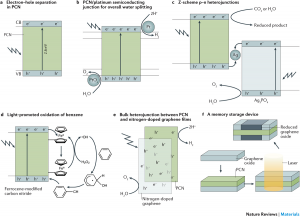Kessler, F. K.; Zheng, Y.; Schwarz, D.; Merschjann, C.; Schnick, W.; Wang, X.; Bojdys,* M. J. Nature Reviews Materials 2017, Article number: 17030 (2017). DOI: 10.1038/natrevmats.2017.30 [OPEN ACCESS]
In the past decade, research in the field of artificial photosynthesis has shifted from simple, inorganic semiconductors to more abundant, polymeric materials. For example, polymeric carbon nitrides have emerged as promising materials for metal-free semiconductors and metal-free photocatalysts. Polymeric carbon nitride (melon) and related carbon nitride materials are desirable alternatives to industrially used catalysts because they are easily synthesized from abundant and inexpensive starting materials. Furthermore, these materials are chemically benign because they do not contain heavy metal ions, thereby facilitating handling and disposal. In this Review, we discuss the building blocks of carbon nitride materials and examine how strategies in synthesis, templating and post-processing translate from the molecular level to macroscopic properties, such as optical and electronic bandgap. Applications of carbon nitride materials in bulk heterojunctions, laser-patterned memory devices and energy storage devices indicate that photocatalytic overall water splitting on an industrial scale may be realized in the near future and reveal a new avenue of ‘post-silicon electronics’.

